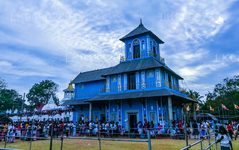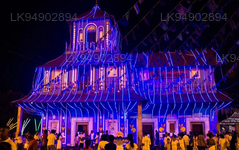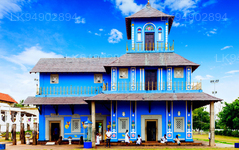
Kandy, pittoresca città dello Sri Lanka centrale, è rinomata per il suo ricco patrimonio culturale, i vivaci festival e la bellezza paesaggistica. Immersa tra lussureggianti colline, ospita il Tempio della Reliquia del Dente di Buddha, patrimonio mondiale dell'UNESCO, e offre un'affascinante combinazione di storia e splendore naturale.
Kandy, pittoresca città dello Sri Lanka centrale, è rinomata per il suo ricco patrimonio culturale, i vivaci festival e la bellezza paesaggistica. Immersa tra lussureggianti colline, ospita il Tempio della Reliquia del Dente di Buddha, patrimonio mondiale dell'UNESCO, e offre un'affascinante combinazione di storia e splendore naturale.
Maha Vishnu Devalaya
On to the North-West of the palace, in front of the “Natha Devale“ is the “Vishnu Devalya” popularly a the “Maha Devale”. This is one of the Hatara Devale in the Kandy, the other three being the Natha, Kataragama and Patini. These four Devalayas have a long association with the Royal Palace ( Maha Vasala) and the Temple of Tooth Relic (Sri Dalada Maligawa) and has been venerated by Buddhists and Hindus alike from the inception.
Different historical documents have called this deity and the Devale by different names. Robert Knox, the English Prisoner has called the deity in this devale “Aluth Nuwara Deiyo”. According to legend the “Aluth Nuwara Deviyo” was brought to Aluth Nuwara in Kegalle District from Devinuwara in Matara. This deity was called “Upulvan Deiyo” (deity with a colour of a lotus). Later this deity in Aluth Nuwara was known as “Vishnu”. The 15th century “Paravi Sandeshaya”, a poetical work describes the deity at Devinuwara, Matara as a destroyer of Asura. Thus it can believed that this same deity is also “Rama” of the great Indian Epic “Ramayana”. Interestingly “Ehelapola Varnanawa”, a poetical work done in the 19th century calls this shrine at Kandy, “The Rama Devale”. It is also interesting to note that this devale has had in possesion a cloth painting depicting the Battle of Rama and Rawana.
“According to Mahavansa, The great chronicle of Sri Lanka, It was “Upulvan Deiyo” thus Vishnu that was selected as the guardian to protect the land of Sri Lanka and Buddhism within it at the time of Buddha’s passing away.
“When the Guide of the World, having accomplished the salvation of the whole world and having reached the utmost stage of blissful rest, was lying on the bed of his nibbana; in the midst of the great assembly of gods, he, the great sage, the greatest of those who have speech, spoke to Sakka’ who stood there near him: `Vijaya, son of king Sihabahu, is come to Lanka from the country of Lala, together with seven hundred followers. In Lanka, O lord of gods, will my religion be established, therefore carefully protect him with his followers and Lanka.
When the lord of gods heard the words of the Buddha he from respect handed over the guardianship of Lanka to the god who is in colour like the lotus.
According to beliefs, Vishnu is a future Buddha after Natha. Therefore Vishnu always has had a high ranking within the deities worshipped by the Sri Lankans. During the Kandyan Era the the Kings “Abisheka Mangallaya” or the Coronation Ceremony was held at this Maha Devale.
The origin of Vishnu Devalya or the shrine of Vishnu is unclear. This is a long building with a storied sanctum at the end. In front the sanctum is a long hall called “dig-ge”. This hall is for dancers and who carry out puja for the deity. Today it is used by the devotees to pray. This building complex is entered through a two storeyed Vahalkada (entrance doorway), to an open hall with timber columns in the middle terrace, a beautifully carved stone flight of steps and the drumming hall. On the upper terrace is another small shrine, the God Dedimunda’s Shrine and a large Bo-tree.
Informazioni sul distretto di Kandy
Il distretto di Kandy si trova nella provincia centrale dello Sri Lanka. Uno dei sette siti Patrimonio dell'Umanità dello Sri Lanka, Kandy un tempo era la dimora dei re di Kandy nel XVI secolo e una fonte di tutta la musica, l'arte, l'artigianato e la cultura del paese. A circa 129 km da Colombo, Kandy è incastonata in un terreno collinare e tutti gli occhi sono attratti dal centro della città, dove il lago di Kandy costituisce un elemento affascinante. Kandy conserva un grande significato religioso per lo Sri Lanka, perché è in questa affascinante città che si trova il Dalada Maligawa o "Tempio del Dente", all'interno del quale giace ben custodita la sacra reliquia del dente del Signore Buddha. Il Giardino Botanico Reale di Peradeniya si trova a circa 5 km a ovest del centro città a Peradeniya ed è visitato da 1,2 milioni di persone all'anno. È il più grande giardino botanico dell'isola. L'Udawatta Kele (Foresta di Udawatta) è un santuario protetto situato nel cuore della città, appena a nord del Tempio del Dente. Kandy è una città a maggioranza singalese; vi sono comunità consistenti appartenenti ad altri gruppi etnici, come Mori e Tamil. Kandy è seconda solo a Colombo, il centro dell'economia dello Sri Lanka. Molte importanti cooperative hanno grandi filiali a Kandy e molte industrie, tra cui tessile, arredamento, informatica e gioielleria, si trovano qui. Molti centri di ricerca agricola si trovano in città. È una fonte di tutta la musica, l'arte, l'artigianato e la cultura del paese. A circa 129 km da Colombo, Kandy è immersa in un terreno collinare e tutti gli occhi sono attratti dal centro della città, dove il Lago di Kandy costituisce un elemento incantevole. Kandy conserva un grande significato religioso per lo Sri Lanka, perché è in questa affascinante città che si trova il Dalada Maligawa o Tempio del Dente, all'interno del quale è ben custodita la sacra reliquia del dente del Signore Buddha.
Informazioni sulla provincia centrale
La Provincia Centrale dello Sri Lanka è costituita principalmente da un territorio montuoso. La provincia ha una superficie di 5.674 km² e una popolazione di 2.421.148 abitanti. Alcune delle città principali includono Kandy, Gampola (24.730), Nuwara Eliya e Bandarawela. La popolazione è un mix di cingalesi, tamil e mori. Sia la capitale collinare Kandy che la città di Nuwara Eliya si trovano nella Provincia Centrale, così come Sri Pada. La provincia produce gran parte del famoso tè di Ceylon, piantato dagli inglesi negli anni '60 dell'Ottocento dopo che una devastante malattia distrusse tutte le piantagioni di caffè della provincia. La Provincia Centrale attrae molti turisti, con città collinari come Kandy, Gampola, Hatton e Nuwara Eliya. Il Tempio del Dente o Dalada Maligawa è il principale luogo sacro della provincia di Central. Il clima è fresco e molte zone intorno ai 1500 metri hanno spesso notti fredde. I pendii occidentali sono molto umidi, con precipitazioni che in alcuni punti raggiungono quasi i 7000 mm all'anno. I pendii orientali appartengono alla zona medio-secca, in quanto ricevono pioggia solo dal monsone di nord-est. Le temperature variano dai 24 °C di Kandy ai soli 16 °C di Nuwara Eliya, che si trova a 1.889 m sul livello del mare. Le montagne più alte dello Sri Lanka si trovano nella Provincia Centrale. Il territorio è prevalentemente montuoso, con profonde valli che lo attraversano. Le due principali regioni montuose sono il massiccio centrale e la catena delle Knuckles, a est di Kandy.


























